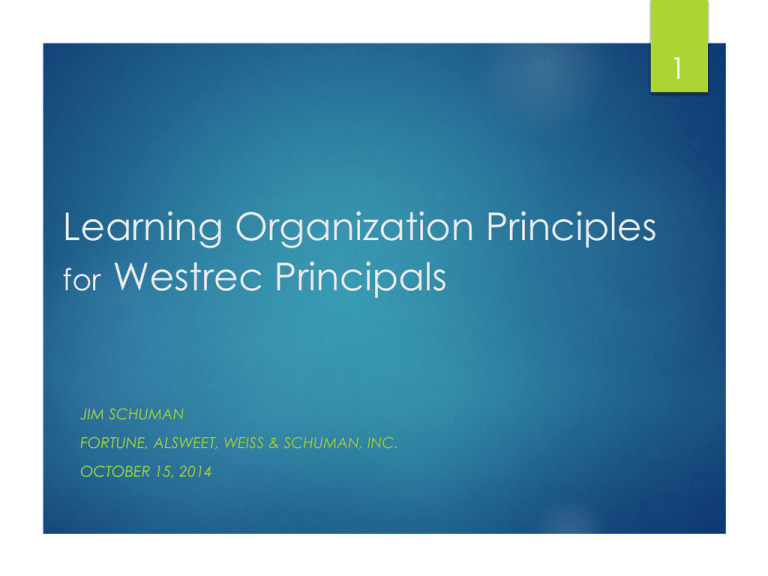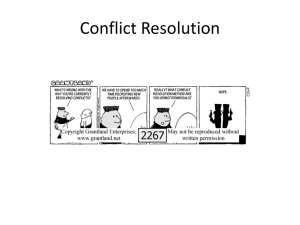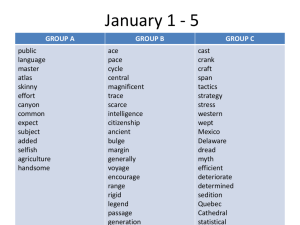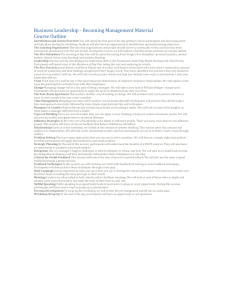Learning Organization Principles for Westrec
advertisement

1 Learning Organization Principles for Westrec Principals JIM SCHUMAN FORTUNE, ALSWEET, WEISS & SCHUMAN, INC. OCTOBER 15, 2014 2 PREMISE • Humans designed for learning • • Psychology 501 Experiences with children 3 FACTS • KIDS DON’T RESIST CHANGE • • They resist being changed… Except when damp… 4 PROVERBIAL “RIGHT” ANSWER • RAMIFICATIONS • • • • React _______________________________ Guess _______________________________ Respond _____________________________ Peer _________________________________ 5 PROGRESSION OR REGRESSION • PRESCHOOL TO ELEMENTARY TO MIDDLE TO HIGH SCHOOL TO COLLEGE & BUSINESS • • Increasing ______________________ Folks do not want to • • Be _____________________________ Or look ________________________ 6 QUIZ: “WALLY” • What kind of men can never die of old age? ___________________________________ • What three-letter word completes the first word and starts the second? DON • CAR ___________________ Why do women in Argentina own more shoes than women in Columbia? ____________________________________ • Who are the most dependable staff in a hospital? ____________________________________ • What does a duck do if it flies upside down? ____________________________________ • How can a man switch off a light that’s 10 feet from his bed and then get into bed before it is dark? _____________________________________ 7 WHAT’D YA GET • Right Answers? • • Competitions and comparisons… Ramifications 8 WHAT’D YOU LEARN? • • • So what? What’s worth knowing? So What? 9 STATISTICS AND DANG STATISTICS • • • 1990 versus 1980 69% of Fortune 500 industrials had _____________________ Dominant business philosophy: “The top _________ and the local ________” • • Leaders focused on ________ or _________ of the organization. Over-whelmed by the forces of status quo 10 STATISTICS AND DANG STATISTICS • In 2012, only 12% of those firms remained • • • • Key to survival --- and for those 88% who filled the ranks? “Abilities to run experiments in the margin” “Continually explored new business opportunities that create new sources for growth & revenue” Audience examples • • What companies come to mind? Characteristics shared? PETER SENGE & FUTURIST NOTIONS AT MIT • Understanding the past • • • The world is made of circles We have been thinking in straight lines… Collaboration is vital to sustain profound or deep change • Without it, organizations are overwhelmed by the ___________________________ • Commitment cannot be forced • • Nudge, nudge --- inspire a little here and there Back to the ________________________ 11 PETER SENGE & FUTURIST NOTIONS AT MIT • Senge & The Sloan School of Management • • • • Adaptive and generational thinking… So What? Creative answers! His team understood that as change accelerated • Then rapid adaptation had to follow 12 PETER SENGE & FUTURIST NOTIONS AT MIT • Linear Steps ---- A to B to C to D no longer adequate • Linear problems: • • • • S-S-M-T- _ - _ -F J-F-M-A- _ - _ O-T-T- _ - _ -S-S-E- _ - _ 78 + 67.5 – 3.97 + 30% of 180 = ______ 13 PETER SENGE & FUTURIST NOTIONS AT MIT • Generational problems: • The English names of 2 major European cities fit the pattern below • Can you name them? __U__ __CH 14 PETER SENGE & FUTURIST NOTIONS AT MIT • Think of a five-letter answer to the clue on top. Then add a “K” to the letters and rearrange them to make a six letter answer to the clue on the bottom. • • Moisten the thanksgiving turkey __________________________ Woven item ___________________________ or • • Garden statuette ________________________ Laos border river ________________________ 15 SUSTAINABLE COMPETITIVE ADVANTAGE • Principals must demonstrate and require increased adaptability • “The only sustainable competitive advantage is the organization’s ability to learn faster than the competition” • So what? 16 17 LEARNING ORGANIZATIONS • Consummately adaptive & creative learning • Targets • Not just right answers • Generative or creative answers • What if? 18 LEARNING ORGANIZATIONS • Opportunities for constant renewal • • • • • • Through learning we re-create ourselves Enabled to do new things Do some things thought impossible Re-perceive our world & relationship to it Extend capacities to create & regenerate Become part of a regenerative process GENERATIONAL THINKING --REAL WORLD TESTS • Applications • Many clients are focusing on generative learning strategies • • • Creating and driving improvements People and performance TQM --- A process, not a program 19 GENERATIONAL THINKING --REAL WORLD TESTS • Evolution emphasis --- “Loopage” • Competitive plan based on continuous study of data and feedback • • • • • Management focused on continuous improvement process Appraisals rate and review performance Requires new ways to look at the world Understand systems that control events React quickly • • Kaizen and Six Sigma ---- Worth your exploration? Look at the new “generation” of companies 20 21 LEADERS’ NEW WORK • Today most successful organizations became learning organizations • Why did “old companies” become extinct • Traditional leaders were people who set the company’s direction • • • • Made key decisions “Energized the troops…” Charisma is their gift in the short term --- but a fickle asset Incompetency was tolerated LEADERSHIP IN LEARNING ORGANIZATIONS • Designers, Teachers, and Stewards --- Not charismatic heroes • Requires new skill sets: • • Ability to build a shared vision • • • Ability to identify audiences Ability to identify and challenge prevailing “mental models” or ways that business is done Ability to identify new products or services Ability to foster new thinking 22 LEADERSHIP IN LEARNING ORGANIZATIONS • Leaders in learning organizations are responsible for building organizations where people are: • • • • Continually expanding their capabilities Shaping the organization and their futures Leaders are responsible for learning And leading change 23 24 CREATIVE TENSION • Creative tension --- The integrating principle • • Leader’s vision begins with this principle Current reality • • • Seeing clearly where we want to be as an organization Understanding “our vision” Telling the truth about where we are---Our current reality 25 CREATIVE TENSION • Creative tension exercise • • • Demonstration So, what’d ya learn? Analogies • • Gaps between vision and current reality Two resolution options: Strategic Visions • • Raising current reality toward the vision Lowering the vision 26 CREATIVE TENSION • Individuals, groups, teams and organizations who learn how to work with creative tension use the energy generated to move reality more reliably toward their strategic vision • • • Without vision there is no creative tension Analysis paralysis The principle of creative tension teaches that an accurate picture of the current reality is as important as a compelling picture of the desired future 27 CREATIVE TENSION • Leading through creative tension is different than solving problems • Problem solving usually involves external motivation • • Get it done! Creative tension triggers intrinsic motivation • What if…? 28 NEW ROLES • Traditional authoritarian image: The boss is calling the shots • • • Overly simplified and inadequate Senge understands that leadership is intertwined with “culture formation” There have always been “designers, stewards and teachers” in organizations • However those roles take on new meaning in learning organizations • Demands new skills and tools 29 NEW ROLES • Imagine that your region, marina, resort, harbor, park, rock company or office or affiliate is an ocean liner and that you are the “Leader”. • What is your role? • • • • ________________________________ ________________________________ ________________________________ ________________________________ 30 NEW ROLES • Neglected leadership role is “Designer” • No one has more sweeping influence than the designer • • • “Turn starboard 30 degrees…” Rudder will only turn to port… It’s futile to be the leader in an organization that is poorly designed 31 NEW ROLES • Functions of design are rarely visible --- strategic • • • • “Social Architecture” takes place behind the scenes Require thought and “EEEEP” factors Patience and “MBWA” will show benefits far in the future Key: building a foundation of purpose and core values 32 NEW ROLES • Leader as steward • Subtlest role of leadership • • • Leaders sense of leadership operates on two levels Appreciation re the impact they have as models rather than critics They involve folks so there is SE=SU=SC (courtesy Sandy!) • • • • SE:_______________________________________ SU:_______________________________________ SC:_______________________________________ Driving engagement or commitment opportunities • • • Enrolled Involved Committed 33 NEW ROLES • Leader as steward • • • All of us are smarter than one of us Crafting strategies and fostering strategic---and lateral---thinking Process • • • • Scenario analysis Encourage managers to think through how they would lead Ferret out implications Planning as a learning opportunity 34 NEW ROLES • Leader as a teacher • First responsibility: Define Reality • • The leader as teacher is not an authoritarian expert Rather a collector of the views of others re the current reality • • Consider events, patterns of behavior & system’s structure Team goals: Listen and learning and planning for today & specific time frames • • • • Collaborate Invent Design Impact 35 LEADER’S FOCUS • Where’s their attention and the organization’s attention? • Traditional organization: “Event Explanation” • • • Dooms leader to a reactive stance to change Pattern of behavior explanations • • • Who did what to whom? Focus on long-term trends & assessing implications Explain how, over time, organization can respond to shifting conditions Structural explanations are the most powerful • Address underlying causes of behavior such that patterns of behavior can be changed 36 SO WHAT? • • Most leaders focus attention on events & patterns of behavior • Leaders in learning organizations pay attention to their responsibilities • • • • Under their direction, their organizations do likewise… Designers, stewards and teachers They teach and coach They focus on stretching the organization with their colleagues They collaborate, invent, design and impact their people customers & community EXPECT THE UNEXPECTED --- OR YOU’LL NEVER FIND IT • Check out the rubber band • • • • What’s next? Be dissatisfied What are you dissatisfied about? What are you going to do about that? 37 EXPECT THE UNEXPECTED---OR YOU’LL NEVER FIND IT • Daring you to chart your course • • When? What will it take to achieve your goals? • • • Incremental accomplishments toward attaining goals Starting with “Making your bed…” Bill’s introduction to video 38





